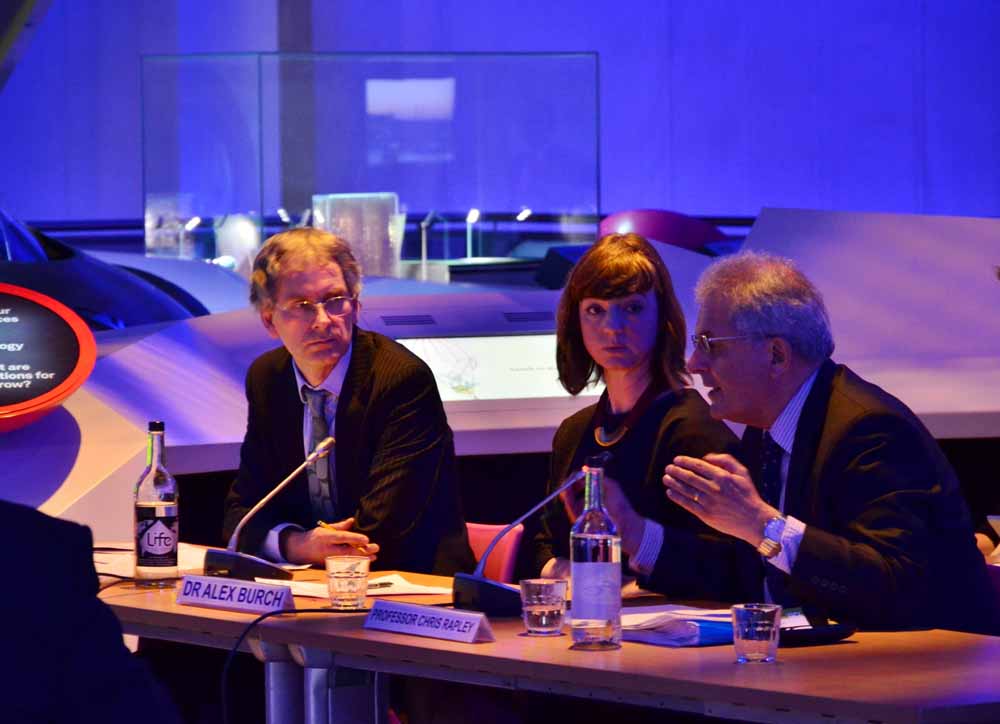Roger Highfield, Director of External Affairs at the Science Museum Group, writes about bringing Westminster to the Science Museum.
The Science Museum witnessed democracy in action this morning when it hosted a meeting of one of the committees used by the House of Commons to provide a means of impartial, systematic scrutiny of government.

The chair of the Science and Technology Select Committee, Andrew Miller MP, has held evidence sessions outside Westminster, notably in Sheffield for its “bridging the valley of death” inquiry into the commercialisation of research and one in Falmouth to take evidence for its inquiry into marine science, so more people can attend without the need to travel to London.
The Committee now wants to uncover what the public understand about climate, where they look for their information and how their understanding may impact policy.
Today Mr Miller and fellow MPs convened in the Atmosphere gallery of the museum – which has explained climate science to more than 1.7 million visitors since it opened in 2010 – to take evidence as part of its inquiry into Climate: Public understanding and policy implications.
‘This is a first,’ said Miller, referring to how the museum is an appropriate location for the inquiry, given its efforts to communicate climate science to a broad audience. The Science Museum has more than three million visitors each year, 37% which are children aged 15 or under.
Among the witnesses was former Science Museum director, Professor Chris Rapley, now of University College London, and Dr Alex Burch, the museum’s Director of Learning.
‘For our visitors, this subject is complex, with an emotional element, and can be overwhelming,’ said Dr Burch.

Dr Burch explained that ‘Various lines of research, for instance at the museum, suggest that for many people climate change was something that happened elsewhere, to other people and in the future.’
The Atmosphere gallery, which has a carefully designed narrative, has been visited by leading figures, including Al Gore, the Chinese Ambassador, and a delegation of MPs from India, Bangladesh and Sri Lanka.
Prof Rapley called the gallery ‘atmospheric’ and ‘unique’ and said it is aimed at everyone, not just the converted, so they can make up their own minds. ‘It is not the job of the museum to tell people what to think.’
In evaluation surveys, visitors described the gallery as ‘interesting’ (88% of surveyed visitors), ‘enjoyable’ (79%) and ‘educational’ (76%).
To accompany Atmosphere, the museum launched a three-year programme of schools outreach around climate science in 2010 with the National Railway Museum in York, Museum of Science and Industry in Manchester, At-Bristol science centre and the Catalyst Science Discovery Centre in Runcorn, which has engaged 3,193 secondary-school students with issues of climate science and its communication, notably through a magazine called Atmos.
The museum has also undertaken more unusual initiatives: an online education game about risk management, RIZK, which has been played 3.3m times since launch; A Cockroach Tour of the Science Museum, a participative art piece by Danish collective Superflex, where visitors explore the Museum and human history and society from the perspective of cockroaches; and Tony White’s e-novel Shackleton’s Man Goes South. White was present at today’s hearing in the gallery, which features his book.
The museum’s qualitative research with adult visitors suggests that understanding of climate science is patchy and disconnected, findings backed by other research, such as a nationwide survey conducted a decade ago by the Economic and Social Research Council which showed, for example, that 44 per cent of the public believe (wrongly) that nuclear power directly contributes to climate change.
Research suggests that while the public generally trust scientists as a source of information about climate change, there is evidence that negative stereotypes of scientists (such as poor communication skills and remoteness) hamper direct public engagement with researchers.
Research indicates an important role for trusted institutions such as the Science Museum that occupy the interface between the scientific community and the public. ‘We are trusted by the public, and by scientists,’ said Dr Burch.
In recognition of hypocrisy as another potential barrier to trust among the public, the Museum undertook various measures during the development of Atmosphere, which include employing a Sustainability Consultant, and setting up a Working Group that reduced the organisation’s carbon footprint by 17% between 2009 and 2010.
The Science Museum Group’s new Hemcrete storage facility at its Wroughton site recently won a Museum and Heritage’s Sustainability award and the Best Workplace New Build category at the Greenbuild Awards.
The Group also aims to generate energy both for our own use, and to send it to the grid. An example of this is the proposed 40MW solar array at the Wroughton site which will provide electricity for around 12,000 homes.